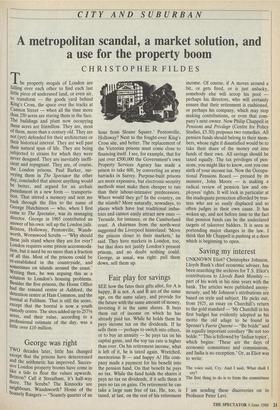CITY AND SUBURBAN
A metropolitan a use scandal, a market solution, and for the property boom
CHRISTOPHER FILDES
The property moguls of London are falling over each other to find each last little piece of underused land, or even air, to transform — the goods yard behind King's Cross, the space over the tracks at Cannon Street — when all the time more than 250 acres are staring them in the face. The buildings and plant now occupying these acres are friendless. They are, most of them, more than a century old. They are not (yet) defended for their architecture or their historical interest. They are well past their natural span of life. They are being subjected to strains for which they were never designed. They are inevitably ineffi- cient and repugnant. They are, of course, the London prisons. Paul Barker, sur- veying them in The Spectator the other day, concluded that almost anything would be better, and argued for an archaic Punishment in a new form — transporta- tion. That stirred a memory and sent me back through the files to the name of George Hutchinson — who, when I first came to The Spectator, was its managing director. George in 1965 contributed an answer of his own: sell up the London jails. Brixton, Holloway, Pentonville, Wands- worth, Wormwood Scrubs — 'Why should these jails stand where they are for ever? London requires some prison accommoda- tion, but it need be no more than a fraction of all this. Most of the prisons could be re-established in the countryside, and sometimes on islands around the coast.' Writing then, he was arguing this as a solution to London's housing problems. Besides the five prisons, the Home Office had the remand centre at Ashford, the detention centre at Ham Common, and the borstal at Feltham. That is still the score, except that the borstal is now a youth custody centre. The sites added up to 2571/2 acres, and their value, according to a Professional estimate of the day, was a little over £10 million.


















































 Previous page
Previous page